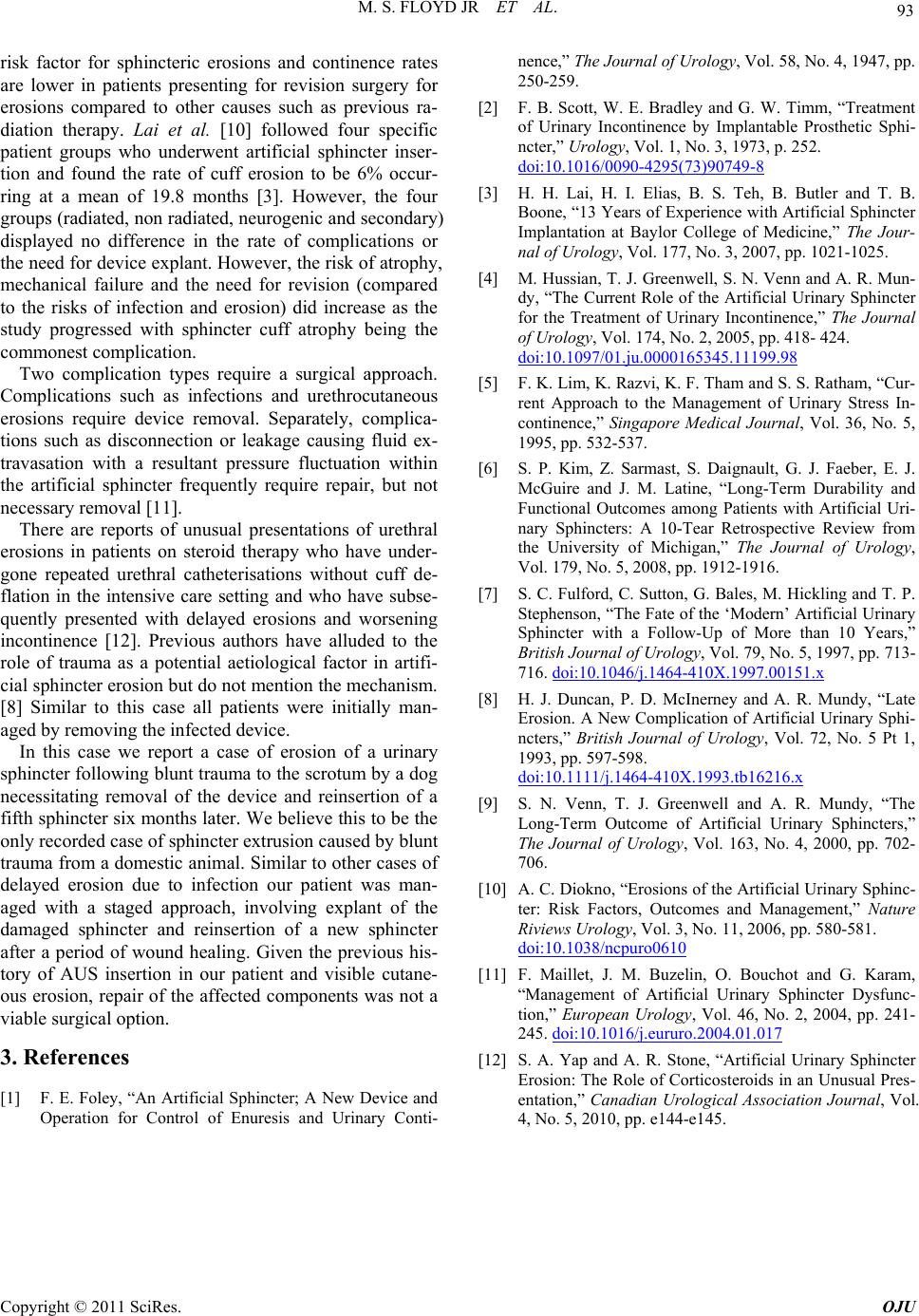
M. S. FLOYD JR ET AL.
Copyright © 2011 SciRes. OJU
93
risk factor for sphincteric erosions and continence rates
are lower in patients presenting for revision surgery for
erosions compared to other causes such as previous ra-
diation therapy. Lai et al. [10] followed four specific
patient groups who underwent artificial sphincter inser-
tion and found the rate of cuff erosion to be 6% occur-
ring at a mean of 19.8 months [3]. However, the four
groups (rad iated, non rad iated, neurogen ic and second ary)
displayed no difference in the rate of complications or
the need for device explant. However, the risk of atrophy,
mechanical failure and the need for revision (compared
to the risks of infection and erosion) did increase as the
study progressed with sphincter cuff atrophy being the
commonest complication.
Two complication types require a surgical approach.
Complications such as infections and urethrocutaneous
erosions require device removal. Separately, complica-
tions such as disconnection or leakage causing fluid ex-
travasation with a resultant pressure fluctuation within
the artificial sphincter frequently require repair, but not
necessary removal [11].
There are reports of unusual presentations of urethral
erosions in patients on steroid therapy who have under-
gone repeated urethral catheterisations without cuff de-
flation in the intensive care setting and who have subse-
quently presented with delayed erosions and worsening
incontinence [12]. Previous authors have alluded to the
role of trauma as a potential aetiological factor in artifi-
cial sphincter erosion but do not mention the mechanism.
[8] Similar to this case all patients were initially man-
aged by removing the infected device.
In this case we report a case of erosion of a urinary
sphincter following blunt trau ma to the scrotum by a dog
necessitating removal of the device and reinsertion of a
fifth sphincter six months later. We believe this to be the
only recorded case of sphincter extrusion caused by blunt
trauma from a domestic animal. Similar to other cases of
delayed erosion due to infection our patient was man-
aged with a staged approach, involving explant of the
damaged sphincter and reinsertion of a new sphincter
after a period of wound healing. Given the previous his-
tory of AUS insertion in our patient and visible cutane-
ous erosion, repair of the affected components was not a
viable surgical option.
3. References
[1] F. E. Foley, “An Artificial Sphincter; A New Device and
Operation for Control of Enuresis and Urinary Conti-
nence,” The Journal of Urology, Vol. 58, No. 4, 1947, pp.
250-259.
[2] F. B. Scott, W. E. Bradley and G. W. Timm, “Treatment
of Urinary Incontinence by Implantable Prosthetic Sphi-
ncter,” Urology, Vol. 1, No. 3, 1973, p. 252.
doi:10.1016/0090-4295(73)90749-8
[3] H. H. Lai, H. I. Elias, B. S. Teh, B. Butler and T. B.
Boone, “13 Years of Experience with Artificial Sphincter
Implantation at Baylor College of Medicine,” The Jour-
nal of Urology, Vol. 177, No. 3, 2007, pp. 1021-1025.
[4] M. Hussian, T. J. Gree nwell, S. N. Venn and A. R. Mun-
dy, “The Current Role of the Artificial Urinary Sphincter
for the Treatment of Urinary Incontinence,” The Journal
of Urology, Vol. 174, No. 2, 2005, pp. 418- 424.
doi:10.1097/01.ju.0000165345.11199.98
[5] F. K. Lim, K. Razvi, K. F. Tham and S. S. Ratham, “Cur-
rent Approach to the Management of Urinary Stress In-
continence,” Singapore Medical Journal, Vol. 36, No. 5,
1995, pp. 532-537.
[6] S. P. Kim, Z. Sarmast, S. Daignault, G. J. Faeber, E. J.
McGuire and J. M. Latine, “Long-Term Durability and
Functional Outcomes among Patients with Artificial Uri-
nary Sphincters: A 10-Tear Retrospective Review from
the University of Michigan,” The Journal of Urology,
Vol. 179, No. 5, 2008, pp. 1912-1916.
[7] S. C. Fulford, C. Sutton, G. Bales, M. Hickling and T. P.
Stephenson, “The Fate of the ‘Modern’ Artificial Urinary
Sphincter with a Follow-Up of More than 10 Years,”
British Journal of Urology, Vol. 79, No. 5, 1997, pp. 713-
716. doi:10.1046/j.1464-410X.1997.00151.x
[8] H. J. Duncan, P. D. McInerney and A. R. Mundy, “Late
Erosion. A New Complication of Artificial Urinary Sphi-
ncters,” British Journal of Urology, Vol. 72, No. 5 Pt 1,
1993, pp. 597-598.
doi:10.1111/j.1464-410X.1993.tb16216.x
[9] S. N. Venn, T. J. Greenwell and A. R. Mundy, “The
Long-Term Outcome of Artificial Urinary Sphincters,”
The Journal of Urology, Vol. 163, No. 4, 2000, pp. 702-
706.
[10] A. C. Diokno, “Erosions of the Artificial Urinary Sphinc-
ter: Risk Factors, Outcomes and Management,” Nature
Riviews Urology, Vol. 3, No. 11, 2006, pp. 580-581.
doi:10.1038/ncpuro0610
[11] F. Maillet, J. M. Buzelin, O. Bouchot and G. Karam,
“Management of Artificial Urinary Sphincter Dysfunc-
tion,” European Urology, Vol. 46, No. 2, 2004, pp. 241-
245. doi:10.1016/j.eururo.2004.01.017
[12] S. A. Yap and A. R. Stone, “Artificial Urinary Sphincter
Erosion: The Role of Corticosteroids in an Unusual Pres-
entation,” Canadian Urological Association Journal, Vol.
4, No. 5, 2010, pp. e144-e145.